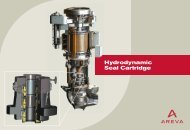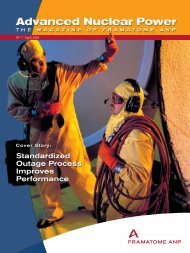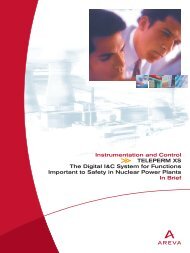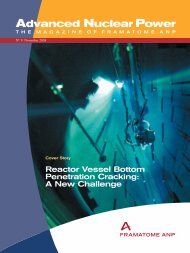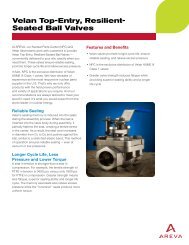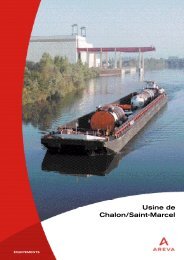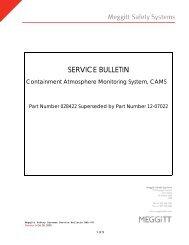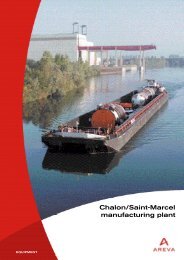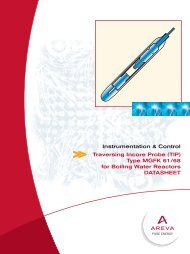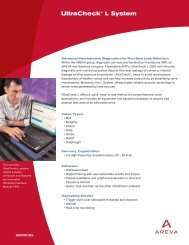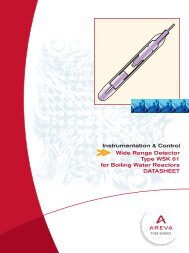EPR – Areva brochure
EPR – Areva brochure
EPR – Areva brochure
You also want an ePaper? Increase the reach of your titles
YUMPU automatically turns print PDFs into web optimized ePapers that Google loves.
■ <strong>EPR</strong> NUCLEAR ISLANDReactor pressure vessel and internals cutawayREACTOR PRESSURE VESSELAND INTERNAL STRUCTURESCRDMadaptatorLevel measurementprobeVessel headControl rodguideassemblyCRDM adaptorthermal sleeveCore barrel†InletnozzleOutletnozzleChalon manufacturing plant (France): Civaux 1 (N4, 1,500 MWe) reactor pressure vesseland its closure head.Reactor Pressure VesselThe Reactor Pressure Vessel (RPV) is the component of theNuclear Steam Supply System that contains the core.A closure head is fastened to the top of the RPV by means of astud-nut-washer set.To minimize the number of large welds, and consequently reducetheir manufacturing cost and time for in-service inspection, the upperpart of the RPV is machined from one single forging and the flangeis integral to the nozzle shell course. Nozzles of the set-on typefacilitate the welding of the primary piping to the RPV and the weldsin-service inspection as well.The lower part of the RPV consists of a cylindrical part at the corelevel, a transition ring and a spherical bottom piece. As the in-coreinstrumentation is introduced through the closure head at the topof the RPV, there is no penetration through the bottom piece.The RPV has been designed to facilitate the non-destructive testingduring in-service inspections. In particular, its internal surface isaccessible to allow 100% visual and/or ultrasonic inspection of thewelded joints from the inside.The RPV closure head is a partly spherical piece with penetrationsfor the control rod drive mechanisms and the in-core instrumentation.The RPV and its closure head are made of forged ferritic steel <strong>–</strong>16 MND 5 <strong>–</strong> a material that combines adequate tensile strength,toughness and weldability. The entire internal surface of the RPVand its closure head are covered with a stainless steel cladding forcorrosion resistance. To contribute to the reduction of the corrosionproducts radiation source term, the cladding material is specifiedwith a low Cobalt residual content.Inside the reactor building, the entire RPV structure (including thereactor core) is supported by a set of integrated pads underneath theeight primary nozzles. These pads rest on a support ring which isthe top part of the reactor pit.Significant safety margin against the risk of brittle fracture (due tomaterial aging under irradiation) during the RPV’s 60 year designlife is ensured.Reactor pressure vessel monobloc upper shell for the Olkiluoto 3 (Finland) <strong>EPR</strong>.Reactorvessel bodyHeavyreflectorIrradiationspecimencapsuleCoresupport plateFlowdistributiondeviceThe ductile-brittle transition temperature (RT NDT ) of the RPV materialremains lower than 30 °C at the end of the design life. This result isobtained from the choice of the RPV material and its specified lowcontent in residual impurities, and also thanks to a reduced neutronfluence to the RPV due to the implementation of a neutron reflectorsurrounding the core and protecting the RPV against the neutronflux.The suppression of any weld between the flange and the nozzle shellcourse plus the set-on design of the nozzles allow an increase ofthe vertical distance between the nozzles and the top of the core.Therefore, in the assumption of a loss of coolant situation, more timeis available for the operator to counteract the risk of having the coreuncovered by the coolant.Rod clustercontrol assemblyRCCAFuel assembly† Consistently with the <strong>EPR</strong> 60-year designlife, an increased margin with regardto Reactor Pressure Vessel (RPV)embrittlement is obtained from neutronfluence reduction (RPV diameter enlarged,neutron heavy reflector, low neutronleakage fuel management) and from RPVmaterial specifications (reduced RT NDT ).† The nozzle axis raising improves the fuelcooling in the event of a loss of coolantaccident.† The elimination of any penetration throughthe RPV bottom head strengthens itsresistance in case of postulated coremeltdown and prevents the need forin-service inspection and potential repairs.† The reduced number of welds andthe weld geometry decrease the needfor in-service inspection, facilitate nondestructiveexaminations and reduceinspection duration as well.† A low Cobalt residual content of thestainless steel cladding is specifiedto less than 0.06% to contribute tothe radiation source term reduction.22 II 23



